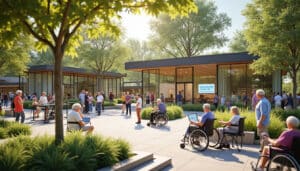China finds itself at a critical crossroads as it prepares to face the challenge of its demographic aging. With an aging population projected to reach nearly 400 million elderly people by 2035, the potential of the silver economy emerges as a promising avenue to address this growing issue. Innovation becomes the essential driver to redefine seniors’ lifestyles and adapt economic sectors to new needs. Thus, the transformation of Chinese society relies on innovative technological solutions and proactive policies aimed at creating a conducive environment for future generations while leveraging the opportunities emerging within the silver economy.

How China Will Innovate to Address Aging Challenges
In the face of the challenges posed by population aging, China is committed to adopting innovative solutions. One of the major focuses is the development of the silver economy, which specifically targets elderly people by offering a diverse range of services and products tailored to their needs. Each year, the number of seniors increases, and the Chinese authorities recognize the crucial importance of acting quickly to support this aging population without compromising economic growth. The emergence of an older workforce presents a set of challenges while also offering unexplored opportunities in technology and services.
The Impact of Super-Intelligent Robots on the Silver Economy
The technological revolution is a major vector of change for China. With the advent of super-intelligent robots, the country aims to transform the home care sector. These technological innovations not only assist seniors in their daily lives but also alleviate the pressure on healthcare services. By leveraging these advancements, China envisions creating an ecosystem where elderly individuals can enjoy a better quality of life while reducing healthcare costs. This could also encourage the development of an agile workforce specialized in managing and maintaining these technologies, thereby creating new jobs in a booming market.
Demographic Policies and Their Role in Innovation
Revisions to demographic policies are also a key element in addressing the challenges related to aging. With initiatives such as the gradual increase of the retirement age, China seeks to integrate part of this active population into the economic system. These adjustments will free up financial resources that can be reinvested in programs aimed at improving the well-being of seniors. Furthermore, incentive policies to encourage birth rates and support young families will be considered to balance the age pyramid, thereby ensuring a more harmonious and sustainable development of the economy.
Innovations in China Facing Population Aging and the Silver Economy
As China prepares to face a future where demographic aging will play a prominent role, the country is implementing innovative strategies to harness the potential of the silver economy. This approach aims not only to meet the growing needs of elderly individuals but also to transform these challenges into new economic opportunities.
The major concern is that China could become an aging nation before it has fully developed its economic potential. To address this, initiatives are underway, with massive investments in technologies such as artificial intelligence and robotics. These technologies can play a key role in supporting population aging, facilitating the daily lives of elderly individuals, while also optimizing healthcare resources.
Another cornerstone of this strategy is the revision of demographic policies. The removal of limits on the number of children per couple and the gradual increase of the retirement age aim to encourage an older and active workforce. This not only increases the labor force but also values the experience and expertise of older generations.
Finally, the silver economy represents a major opportunity for the development of the tourism sector and services dedicated to seniors, thereby creating jobs and boosting the market. By focusing efforts on innovation and inclusivity, China is not only looking to address a demographic issue but also to build a future where elderly individuals are seen as a valuable resource, actively contributing to society and the economy.







